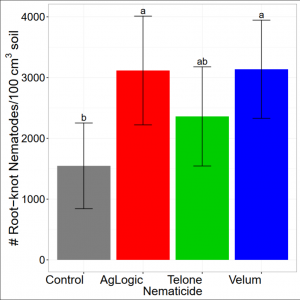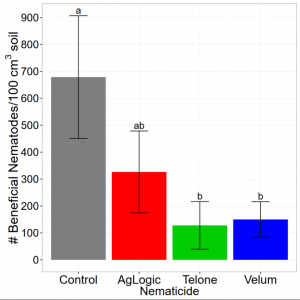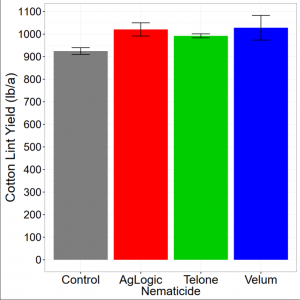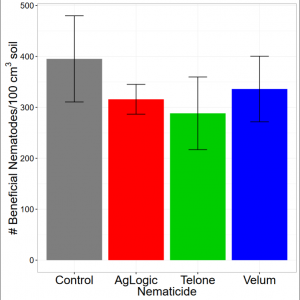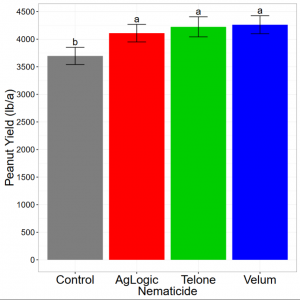
Patchy chlorosis in the 2017 on-farm peanut nematicide trial due to peanut root-knot nematode infection. Credit: Zane Grabau
Authors: Zane Grabau, UF/IFAS Nemotologist, Ethan Carter, UF/IFAS Regional Crop IPM Agent, and Mark Mauldin, Washington County Extension Agent
Plant-parasitic nematodes are a major pest for cotton and peanut in the Southeast. New or re-introduced non-fumigant nematicides, applied as a liquid or granular formulation, have become available in the last few years. Available nematicides were compared in on-farm cotton and peanut nematicide trials in the Panhandle in 2017.
Trial Layout
The trials were conducted at an irrigated commercial farm in Jackson County. The cotton site was infested with southern root-knot nematode (Meloidogyne incognita) whereas the peanut site was infested with peanut root-knot nematode (Meloidogyne arenaria). Nematode pressure was moderate in both trials. Treatments were applied in strips across the length of the field (4 rows wide for peanut and 12 rows wide for cotton) and replicated 4 times.
Treatments consisted of 4 nematicide regimes:
- No nematicide (control)
- Telone II (1,3-Dichloropropene) fumigant at 3.5 gal/a shank-applied in the row followed by rolling basket to close furrow 3 weeks before planting.
- Velum Total (fluopyram+imidicloprid) at 18 oz/a applied in-furrow at planting as a liquid spray
- AgLogic 15GG (aldicarb) at 7 lb/a applied in-furrow at planting as a granular
Soil nematode populations were assessed from a 50’ section of each strip and populations at harvest were recorded. Both root-knot nematodes and beneficial nematodes were measured. Beneficial nematodes are non-parasitic nematodes that feed on fungi, bacteria, or other nematodes and can help cycle nutrients into plant-available forms. Crop yields were also measured for each strip.
Cotton nematicide trial results
Just before harvest, soil root-knot nematode juvenile counts were greater (Fisher’s Least Significant Difference, P<0.05) in nematicide treatment plots than the untreated areas (Figure 1).
It is not uncommon for final nematode counts to be greater in nematicide-treated areas, due to a more vigorous root system providing more material for nematode infection and growth. In contrast, beneficial nematode abundances were significantly greater in the untreated control plots in the fall (Figure 2). This suggests nematicide application was harmful for beneficial organisms.
Cotton lint yield was statistically similar among nematicide application treatments, but was numerically smaller without nematicide application (Figure 3).
Table 1 shows rough calculations of income for each treatment based on yields and product cost for 2017, but not including extra equipment or fuel costs for applying each nematicide. Based on these calculations, it was profitable to apply Velum Total or AgLogic, but it was not profitable to apply Telone in this trial. Telone application also requires an additional pass with a tractor and specialized equipment, so there are additional costs for that treatment.
Peanut nematicide trial results
Nematicide application did not significantly affect soil population densities of root-knot nematodes or beneficial nematodes just before harvest (Figures 4 and 5).
Peanut yield was significantly less for the untreated control plots than any of the nematicide treatments (see Figure 6).
Because nematode populations are patchy, and only a portion of each strip was sampled, it is not surprising nematicides increased yield despite not controlling nematode abundances or galling in the portion of the trial sampled. Effective nematicides provide early-season nematode control which increases crop yields, but in many cases, nematicide application does not consistently provide season-long control of nematodes. Based on rough calculations of product cost and peanut prices in 2017, it was profitable to apply any of the three nematicides (Table 2). Velum Total was the most profitable to apply, due to slightly greater yields and lower product cost than the other two products. As mentioned for cotton, growers will also have to consider the extra costs of specialized equipment and additional tractor passes when applying Telone.
Summary and action items
Nematicide applications did increase crop yield and income in the first year of this test. Non-fumigant nematicides Velum Total and AgLogic 15GG performed similarly to low rates of Telone, suggesting these products have value in row crop production. However, none of the nematicides consistently reduced final nematode abundances, which reinforces the need for additional strategies to achieve long-term nematode control, such as crop rotation and use of resistant cultivars. These on-farm trials will be repeated in 2018, which will provide further information on the relative value of these nematicides.
Action items:
-
Determine nematode pressure by taking soil samples when considering nematode management, including nematicide application.
-
Consider research results and economics when choosing a nematicide.
-
Integrate multiple forms of management into your nematode management plan including nematicide application, crop rotation, use of resistant cultivars, and weed management.
For more information on nematode management, use the following publication links:
Management of Plant-Parasitic Nematodes in Florida Cotton Production
Management of Plant-Parasitic Nematodes in Florida Peanut Production

